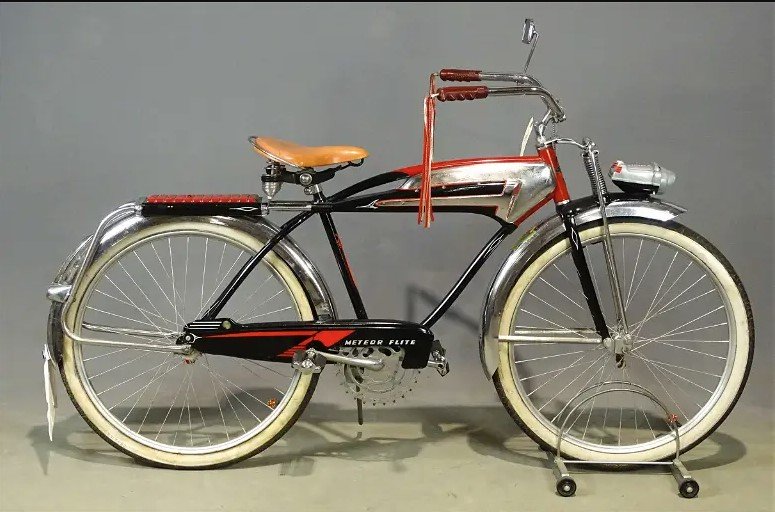In the realm of bicycles, few names evoke the nostalgia and enduring appeal of Western Flyer. For generations, these sturdy steeds have graced the streets, carrying riders of all ages on countless adventures. With their iconic red frames and gleaming chrome accents, Western Flyers epitomize classic bicycle design, captivating collectors and enthusiasts alike.
Identifying a Western Flyer bicycle can be a rewarding endeavor, opening a window into the rich history of cycling and the unique craftsmanship of these American-made masterpieces. Whether you’ve inherited a family heirloom or stumbled upon a charming find at a flea market, decoding the markings and features of your Western Flyer for proper identification can unveil its age, model, and significance.
This guide will help you accurately identify your vintage Western Flyer bicycle using serial numbers, component assessment, model specifications, and other key details that provide insight into the origins and backstory of these iconic bikes. Learning the nuances of western flyer bicycle identification will allow you to properly catalogue your bicycle’s place in history.
Introduction to the Western Flyer Bicycle Brand
Emerging in the 1930s as the house brand of Western Auto Supply stores, the Western Flyer bicycle line captured the essence of cycling’s Golden Age. These classic rides blended superior craftsmanship, innovative style, and high quality materials into durable, yet affordable packages for riders of all ages.
Whether it was the no-nonsense practicality of the townie Roadster, the rugged adventurous spirit of the mountain-conquering Autocycle, or the speed and performance of lightweight racers, Western Flyer models filled every niche. As family weekend wanders, backcountry explorations and neighborhood jaunts propelled the bicycling boom, Western Flyer capitalized on this enthusiasm to become ubiquitous across America.
Lean and nimble road frames, comfortable cruisers and workhorse utility models pretty much made Western Flyer synonymous with bicycling in the middle decades of the 20th century. They epitomized the flowering romance between Americans and the notion of two-wheeled freedom.
Yet when many competitors outsourced manufacturing in the name of costs, Western Flyer doubled down on domestic production and American labor. This commitment to stateside craftsmanship and quality materials burnished the mystique of the brand. Riding a Western Flyer meant supporting American workers and American communities.
Now decades later, as vintage Western Fliers emerge from barns, basements and backyard sheds, a new generation is rediscovering these wheels of yesteryear. The signature head badges, ubiquitous red frames, and glistening chrome that graced small town and urban streets 50+ years ago is spurring a new wave of bicycling nostalgia. These classic rides may no longer dominate sales floors, but their legacy still propels the American cycling dream.
Western Flyer Bicycle Identification Step-by-step guide
Start by Checking for Paperwork and Questioning Previous Owners
If purchased used, reach out to prior owners if possible and ask key questions:
- Where and when did you get this bike?
- Do you have the original sales paperwork or receipts with a date?
- Are there any details on where it was manufactured or sold originally?
While many undocumented vintage bikes have murky histories, previous owners may recall or have records offering clues.
Leverage Local Bike Shop Expertise
Beyond previous owners, tap local bike shop staff and mechanics. Experts can date manufacturing hallmarks like serial numbers, welding/paint details, frame materials, component brands, etc. Their cycling historical knowledge often far surpasses online searches.
Bike shops also maintain networks of regional collectors and historians that may be able to trace esoteric details on older Western Flyers made/sold nearby. The brand has changed hands between various parent companies over 100+ years, so local insights can prove invaluable.
Compare Identifying Marks Against Archives
Every Western Flyer has serial numbers stamped on the frame, commonly on the headset, crank housing or bike tubing. While formats vary by era, the first numbers typically denote manufacturing dates.
Search online catalog archives and collector forums for number sequences starting with your bike’s initial digits to uncover likely model years. Compare against any catalog images showing the same frame style and components to zero in on probable matches.
Auction/Sale Listings Offer Visual Comparison
Sites like eBay feature numerous vintage Western Flyers for sale at any given time. Browse models similar in style to your bike and note key descriptive details from sellers and collection enthusiasts.
Does your bike share the same paint colors, materials, component brands, signs of aging/use? Factor those consistently matching characteristics into probable date ranges and manufacturing origins.
Post Detailed Images and Questions to Online Communities
If your solo sleuthing still leaves questions unanswered, tap the collective knowledge of cycling enthusiasts on niche forums, collector sites and subreddits.
In your inquires, include clear close-up photography capturing identifiable traits like serial markers, logos, welding techniques. List all visual details you notice around materials, wear patterns, part brands and style elements. The deeper the detail, the more precise the guidance avid collectors can provide.
While some vintage Western Flyers may never divulge clear origins, patient research can still determine approximate age. And unraveling a bike’s backstory often means connecting with others who share your passion. Let the hunt for clues open new chapters in the wonderful history these iconic rides continue tracing.
How to Determine the Current Value of Your Vintage Western Flyer Bicycle
Once you’ve accurately identified the year, model and component origination of your Western Flyer, it’s time to value your bicycle. In general, vintage Western Flyers break down into three collector interest and value levels:
- Top Tier Collectibles: The 1933 art deco Silver Kings and early pre-war Super models with premium details can fetch $2,000-$6,000 depending on condition, components and rarity.
- Mid-level Middleweights: Well-preserved models from the 1950s-60s like the X-53 and Golden Flyer in original condition with features like tank, rack, light can sell for $400-$1,500.
- Entry level Sears bikes: Very common mass-produced roadsters and sting-rays from the 60s-70s that were sold through Western Auto often go for less than $300.
Checking current auction listings for comparable Western Flyer models to yours will give you the best indication of current market value. Joining vintage bicycle collector groups and talking to experts is also advised when appraising more valuable restoration-worthy bicycles.
Finding current fair market value for vintage Western Flyers requires properly identifying key information about year, components and condition. Use the tips in this guide to accurately assess your bicycle and unlock its history. For collectors and enthusiasts alike, few things compare to rediscovering the magic of an iconic classic like the Western Flyer.
A Western Flyer is more than a bicycle, it represents a living piece of American history. By identifying the serial numbers, model style, and component origination, you can unlock your Western Flyer’s unique place in time. If you’d like to learn more about preserving, riding, or restoring vintage bicycles like your Western Flyer, visit our partners at Best Bike Parks. There you’ll find insights into the enduring mystique and power of classic American bicycles like Western Flyers to spark adventure for generations of two-wheel explorers.









